Towards a New MAX-DOAS Measurement Site in the Po Valley: Aerosol Optical Depth and NO2 Tropospheric VCDs
Abstract
1. Introduction
2. Materials and Methods
2.1. The SkySpec-2D MAX-DOAS Measurements at San Pietro Capofiume
2.2. Retrieval of Tropospheric Profiles
2.2.1. The DEAP Retrieval Code and Set-Up
2.2.2. MMF Description and Set-Up
2.2.3. MAPA Description and Set-Up
2.2.4. BOREAS Description and Set-Up
2.3. Correlative Data
2.3.1. MODIS-MAIAC
2.3.2. Sentinel-5P TROPOMI
3. Results
3.1. DEAP Validation
3.1.1. DEAP vs. MAPA, MMF and BOREAS with Synthetic dSCDs
3.1.2. DEAP vs. MAPA, MMF and BOREAS with Real dSCDs
3.2. San Pietro Capofiume Dataset of NO2 Tropospheric VCDs and AODs
3.3. Inter-Comparison with Satellite Data
4. Discussion
5. Conclusions
Author Contributions
Funding
Data Availability Statement
Acknowledgments
Conflicts of Interest
Abbreviations
| ACTRIS | Aerosol, Clouds and Trace gases Research InfraStructure |
| AERONET | AErosol RObotic NETwork |
| AOD | Aerosol Optical Depth |
| ARPAE | Agenzia Regionale per la Prevenzione, l’Ambiente e l’Energia |
| BOREAS | Bremen Optimal estimation REtrieval for Aerosols and trace gaseS |
| box-AMFs | Box-Air Mass Factors |
| CAMS | Copernicus Atmosphere Monitoring Service |
| CI | Color Index |
| CNR-ISAC | Consiglio Nazionale delle Ricerche-Istituto di Scienze dell’Atmosfera e del Clima |
| DEAP | DOAS optimal Estimation Atmospheric Profile |
| DOAS | Differential Optical Absorption Spectroscopy |
| DOFs | Degrees Of Freedom |
| EE | Expected Error |
| ESA | European Space Agency |
| FRM4DOAS | Fiducial Reference Measurements for Ground-Based DOAS |
| GCOS | Global Climate Observing System |
| GOME | Global Ozone Monitoring Experiment |
| IDEAS+QA4EO | Instrument Data Evaluation and Analysis Service Quality Assurance for Earth Observation |
| MAIAC | Multi-Angle Implementation of Atmospheric Correction |
| MAPA | MAinz Profile Algorithm |
| MAX-DOAS | Multi-AXis-DOAS |
| MODIS | Moderate Resolution Imaging Spectroradiometer |
| MMF | Mexican MAX-DOAS Fit |
| MPIC | Max Planck Institute for Chemistry |
| RTM | Radiative Transfer Model |
| SCD | Slant Column Densitiy |
| SPC | San Pietro Capofiume |
| SZA | Solar Zenith Angle |
| TROPOMI | TROPOspheric Monitoring Instrument |
| UV | Ultraviolet |
| VCD | Vertical Column Densities |
| VCM | variance-covariance matrix |
| VIS | Visible |
Appendix A

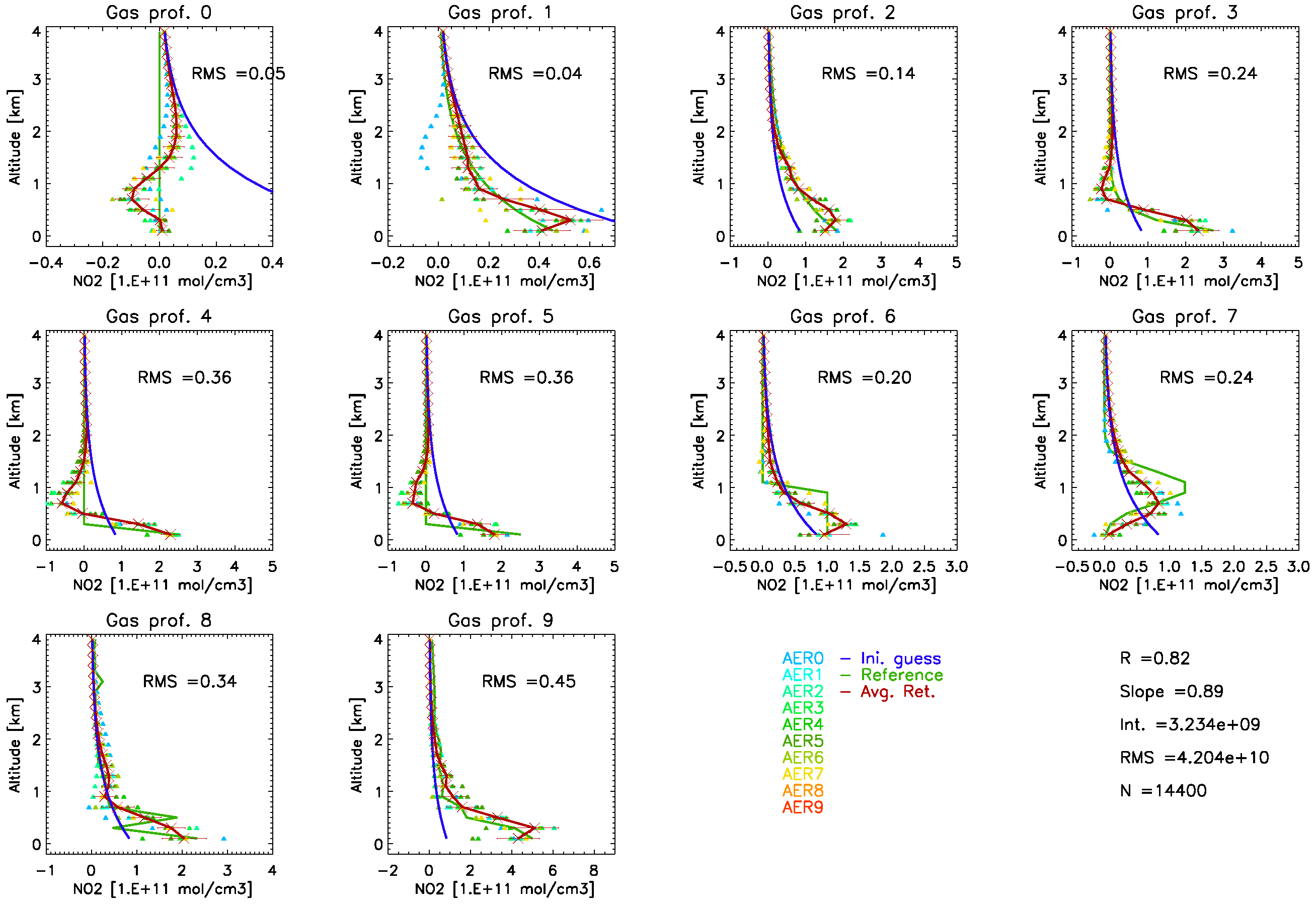
References
- Fiore, A.M.; Naik, V.; Spracklen, D.V.; Steiner, A.; Unger, N.; Prather, M.; Bergmann, D.; Cameron-Smith, P.J.; Cionni, I.; Collins, W.J.; et al. Global air quality and climate. Chem. Soc. Rev. 2012, 41, 6663–6683. [Google Scholar] [CrossRef]
- Logan, J.A. Nitrogen oxides in the troposphere: Global and regional budgets. J. Geophys. Res. Ocean. 1983, 88, 10785–10807. [Google Scholar] [CrossRef]
- Olivier, J.; Bouwman, A.; Van der Hoek, K.; Berdowski, J. Global air emission inventories for anthropogenic sources of NOx, NH3 and N2O in 1990. Environ. Pollut. 1998, 102, 135–148. [Google Scholar] [CrossRef]
- Chan, A.; Chan, M.; Surratt, J.; Chhabra, P.; Loza, C.; Crounse, J.; Yee, L.; Flagan, R.; Wennberg, P.; Seinfeld, J. Role of aldehyde chemistry and NOx concentrations in secondary organic aerosol formation. Atmos. Chem. Phys. 2010, 10, 7169–7188. [Google Scholar] [CrossRef]
- Lelieveld, J.; Dentener, F.J. What controls tropospheric ozone? J. Geophys. Res. Atmos. 2000, 105, 3531–3551. [Google Scholar] [CrossRef]
- Veefkind, J.P.; Aben, I.; McMullan, K.; Forster, H.; de Vries, J.; Otter, G.; Claas, J.; Eskes, H.J.; de Haan, J.F.; Kleipool, Q.; et al. TROPOMI on the ESA Sentinel-5 Precursor: A GMES mission for global observations of the atmospheric composition for climate, air quality and ozone layer applications. Remote Sens. Environ. 2012, 120, 70–83. [Google Scholar] [CrossRef]
- Loew, A.; Bell, W.; Brocca, L.; Bulgin, C.E.; Burdanowitz, J.; Calbet, X.; Donner, R.V.; Ghent, D.; Gruber, A.; Kaminski, T.; et al. Validation practices for satellite-based Earth observation data across communities. Rev. Geophys. 2017, 55, 779–817. [Google Scholar] [CrossRef]
- Yombo Phaka, R.; Merlaud, A.; Pinardi, G.; Friedrich, M.M.; Van Roozendael, M.; Müller, J.F.; Stavrakou, T.; De Smedt, I.; Hendrick, F.; Dimitropoulou, E.; et al. Ground-based Multi-AXis Differential Optical Absorption Spectroscopy (MAX-DOAS) observations of NO2 and H2CO at Kinshasa and comparisons with TROPOMI observations. Atmos. Meas. Tech. 2023, 16, 5029–5050. [Google Scholar] [CrossRef]
- Chan, K.L.; Wiegner, M.; van Geffen, J.; De Smedt, I.; Alberti, C.; Cheng, Z.; Ye, S.; Wenig, M. MAX-DOAS measurements of tropospheric NO2 and HCHO in Munich and the comparison to OMI and TROPOMI satellite observations. Atmos. Meas. Tech. 2020, 13, 4499–4520. [Google Scholar] [CrossRef]
- Judd, L.M.; Al-Saadi, J.A.; Szykman, J.J.; Valin, L.C.; Janz, S.J.; Kowalewski, M.G.; Eskes, H.J.; Veefkind, J.P.; Cede, A.; Mueller, M.; et al. Evaluating Sentinel-5P TROPOMI tropospheric NO2 column densities with airborne and Pandora spectrometers near New York City and Long Island Sound. Atmos. Meas. Tech. 2020, 13, 6113–6140. [Google Scholar] [CrossRef]
- Ialongo, I.; Virta, H.; Eskes, H.; Hovila, J.; Douros, J. Comparison of TROPOMI/Sentinel-5 Precursor NO2 observations with ground-based measurements in Helsinki. Atmos. Meas. Tech. 2020, 13, 205–218. [Google Scholar] [CrossRef]
- Platt, U.; Stutz, J.; Platt, U.; Stutz, J. Differential Absorption Spectroscopy; Springer: Berlin/Heidelberg, Germany, 2008. [Google Scholar]
- Hönninger, G.; Von Friedeburg, C.; Platt, U. Multi axis differential optical absorption spectroscopy (MAX-DOAS). Atmos. Chem. Phys. 2004, 4, 231–254. [Google Scholar] [CrossRef]
- Wagner, T.; Dix, B.v.; Friedeburg, C.v.; Frieß, U.; Sanghavi, S.; Sinreich, R.; Platt, U. MAX-DOAS O4 measurements: A new technique to derive information on atmospheric aerosols—Principles and information content. J. Geophys. Res. Atmos. 2004, 109, D22205. [Google Scholar] [CrossRef]
- Irie, H.; Takashima, H.; Kanaya, Y.; Boersma, K.; Gast, L.; Wittrock, F.; Brunner, D.; Zhou, Y.; Van Roozendael, M. Eight-component retrievals from ground-based MAX-DOAS observations. Atmos. Meas. Tech. 2011, 4, 1027–1044. [Google Scholar] [CrossRef]
- Hendrick, F.; Müller, J.F.; Clémer, K.; Wang, P.; De Mazière, M.; Fayt, C.; Gielen, C.; Hermans, C.; Ma, J.; Pinardi, G.; et al. Four years of ground-based MAX-DOAS observations of HONO and NO2 in the Beijing area. Atmos. Chem. Phys. 2014, 14, 765–781. [Google Scholar] [CrossRef]
- Wang, Y.; Lampel, J.; Xie, P.; Beirle, S.; Li, A.; Wu, D.; Wagner, T. Ground-based MAX-DOAS observations of tropospheric aerosols, NO2, SO2 and HCHO in Wuxi, China, from 2011 to 2014. Atmos. Chem. Phys. 2017, 17, 2189–2215. [Google Scholar] [CrossRef]
- Van Roozendael, M.; Hendrick, F.; Friedrich, M.; Fayt, C.; Bais, A.; Beirle, S.; Bösch, T.; Navarro Comas, M.; Friess, U.; Karagkiozidis, D.; et al. Fiducial Reference Measurements for Air Quality Monitoring Using Ground-Based MAX-DOAS Instruments (FRM4DOAS). Remote Sens. 2024, 16, 4523. [Google Scholar] [CrossRef]
- Donner, S.; Kuhn, J.; Van Roozendael, M.; Bais, A.; Beirle, S.; Bösch, T.; Bognar, K.; Bruchkouski, I.; Chan, K.L.; Dörner, S.; et al. Evaluating different methods for elevation calibration of MAX-DOAS (Multi AXis Differential Optical Absorption Spectroscopy) instruments during the CINDI-2 campaign. Atmos. Meas. Tech. 2020, 13, 685–712. [Google Scholar] [CrossRef]
- Frieß, U.; Beirle, S.; Alvarado Bonilla, L.; Bösch, T.; Friedrich, M.M.; Hendrick, F.; Piters, A.; Richter, A.; Van Roozendael, M.; Rozanov, V.V.; et al. Intercomparison of MAX-DOAS vertical profile retrieval algorithms: Studies using synthetic data. Atmos. Meas. Tech. 2019, 12, 2155–2181. [Google Scholar] [CrossRef]
- Pettinari, P.; Castelli, E.; Papandrea, E.; Busetto, M.; Valeri, M.; Dinelli, B.M. Towards a New MAX-DOAS Measurement Site in the Po Valley: NO2 Total VCDs. Remote Sens. 2022, 14, 3881. [Google Scholar] [CrossRef]
- Bösch, T.; Rozanov, V.; Richter, A.; Peters, E.; Rozanov, A.; Wittrock, F.; Merlaud, A.; Lampel, J.; Schmitt, S.; De Haij, M.; et al. BOREAS—A new MAX-DOAS profile retrieval algorithm for aerosols and trace gases. Atmos. Meas. Tech. 2018, 11, 6833–6859. [Google Scholar] [CrossRef]
- Friedrich, M.M.; Rivera, C.; Stremme, W.; Ojeda, Z.; Arellano, J.; Bezanilla, A.; García-Reynoso, J.A.; Grutter, M. NO2 vertical profiles and column densities from MAX-DOAS measurements in Mexico City. Atmos. Meas. Tech. 2019, 12, 2545–2565. [Google Scholar] [CrossRef]
- Beirle, S.; Dörner, S.; Donner, S.; Remmers, J.; Wang, Y.; Wagner, T. The Mainz profile algorithm (MAPA). Atmos. Meas. Tech. 2019, 12, 1785–1806. [Google Scholar] [CrossRef]
- Salomonson, V.V.; Barnes, W.; Maymon, P.W.; Montgomery, H.E.; Ostrow, H. MODIS: Advanced facility instrument for studies of the Earth as a system. IEEE Trans. Geosci. Remote Sens. 1989, 27, 145–153. [Google Scholar] [CrossRef]
- Pettinari, P.; Valeri, M.; Papandrea, E.; Castelli, E.; Di Liberto, L.; Marinoni, A.; Decesari, S. Report on the MAX-DOAS Analysis Chain. Technical Report. 2023. Available online: https://zenodo.org/records/10033174 (accessed on 8 July 2024). [CrossRef]
- Rodgers, C.D. Inverse Methods for Atmospheric Sounding: Theory and Practice; World Scientific: London, UK, 2000; Volume 2. [Google Scholar]
- Rozanov, V.; Rozanov, A.; Kokhanovsky, A.A.; Burrows, J. Radiative transfer through terrestrial atmosphere and ocean: Software package SCIATRAN. J. Quant. Spectrosc. Radiat. Transf. 2014, 133, 13–71. [Google Scholar] [CrossRef]
- Henyey, L.G.; Greenstein, J.L. Diffuse radiation in the Galaxy. Astrophys. J. 1941, 93, 70–83. [Google Scholar] [CrossRef]
- Wagner, T.; Apituley, A.; Beirle, S.; Dörner, S.; Friess, U.; Remmers, J.; Shaiganfar, R. Cloud detection and classification based on MAX-DOAS observations. Atmos. Meas. Tech. 2014, 7, 1289–1320. [Google Scholar] [CrossRef]
- Gielen, C.; Van Roozendael, M.; Hendrick, F.; Pinardi, G.; Vlemmix, T.; De Bock, V.; De Backer, H.; Fayt, C.; Hermans, C.; Gillotay, D.; et al. A simple and versatile cloud-screening method for MAX-DOAS retrievals. Atmos. Meas. Tech. 2014, 7, 3509–3527. [Google Scholar] [CrossRef]
- Wagner, T.; Beirle, S.; Remmers, J.; Shaiganfar, R.; Wang, Y. Absolute calibration of the colour index and O4 absorption derived from Multi AXis (MAX-) DOAS measurements and their application to a standardised cloud classification algorithm. Atmos. Meas. Tech. 2016, 9, 4803–4823. [Google Scholar] [CrossRef]
- Sarkissian, A.; Pommereau, J.P.; Goutail, F. Identification of polar stratospheric clouds from the ground by visible spectrometry. Geophys. Res. Lett. 1991, 18, 779–782. [Google Scholar] [CrossRef]
- Sarkissian, A.; Pommereau, J.P.; Goutail, F.; Kyro, E. PSC and volcanic aerosol observations during EASOE by UV-visible ground-based spectrometry. Geophys. Res. Lett. 1994, 21, 1319–1322. [Google Scholar] [CrossRef]
- Enell, C.F.; Steen, Å.; Wagner, T.; Frieß, U.; Pfeilsticker, K.; Platt, U.; Fricke, K.H. Occurrence of polar stratospheric clouds at Kiruna. Ann. Geophys. 1999, 17, 1457–1462. [Google Scholar] [CrossRef]
- Spurr, R.J. VLIDORT: A linearized pseudo-spherical vector discrete ordinate radiative transfer code for forward model and retrieval studies in multilayer multiple scattering media. J. Quant. Spectrosc. Radiat. Transf. 2006, 102, 316–342. [Google Scholar] [CrossRef]
- Clemer, K.; Van Roozendael, M.; Fayt, C.; Hendrick, F.; Hermans, C.; Pinardi, G.; Spurr, R.; Wang, P.; De Maziere, M. Multiple wavelength retrieval of tropospheric aerosol optical properties from MAXDOAS measurements in Beijing. Atmos. Meas. Tech. 2010, 3, 863–878. [Google Scholar] [CrossRef]
- Pinardi, G.; Van Roozendael, M.; Hendrick, F.; Theys, N.; Abuhassan, N.; Bais, A.; Boersma, F.; Cede, A.; Chong, J.; Donner, S.; et al. Validation of tropospheric NO2 column measurements of GOME-2A and OMI using MAX-DOAS and direct sun network observations. Atmos. Meas. Tech. 2020, 13, 6141–6174. [Google Scholar] [CrossRef]
- Lyapustin, A.; Wang, Y.; Korkin, S.; Huang, D. MODIS collection 6 MAIAC algorithm. Atmos. Meas. Tech. 2018, 11, 5741–5765. [Google Scholar] [CrossRef]
- Mhawish, A.; Banerjee, T.; Sorek-Hamer, M.; Lyapustin, A.; Broday, D.M.; Chatfield, R. Comparison and evaluation of MODIS Multi-angle Implementation of Atmospheric Correction (MAIAC) aerosol product over South Asia. Remote Sens. Environ. 2019, 224, 12–28. [Google Scholar] [CrossRef]
- KNMI. Sentinel 5 Precursor/TROPOMI KNMI and SRON level 2 Input Output Data Definition. Technical Report S5PKNMI-L2-0009-SD, Koninklijk Nederlands Meteorologisch Instituut (KNMI), 2019. Issue 11.0.0. Available online: https://sentinel.esa.int/documents/247904/3119978/Sentinel-5P-Level-2-Input-Output-Data-Definition (accessed on 11 January 2020).
- Loyola, D.; Lutz, R.; Argyrouli, A.; Spurr, R. S5P/TROPOMI ATBD Cloud Products. S5P-DLR-L2-ATBD-400I Issue 2.2. Technical Report. 2020. Available online: https://sentiwiki.copernicus.eu/__attachments/1673595/S5P-DLR-L2-ATBD-400I%20-%20Sentinel-5P%20TROPOMI%20ATBD%20Clouds%202021%20-%202.3.pdf?inst-v=eb3ebc83-2add-4c9e-b1a4-216e51171ba4 (accessed on 5 March 2025).
- Eskes, H.; van Geffen, J.; Folkert, B.; Kai-Uwe, E.; Arnoud, A.; Mattia, P.; Maarten, S.; Pepijn, V.J.; Loyola, D. Sentinel-5 Precursor/TROPOMI Level 2 Product User Manual Nitrogendioxide. Technical Report, 2021. S5P-KNMI-L2-0021-MA, Koninklijk Nederlands Meteorologisch Instituut (KNMI), CI-7570-PUM, Issue 4.0.2. Available online: https://sentinels.copernicus.eu/documents/247904/2474726/Sentinel-5P-Level-2-Product-User-Manual-Nitrogen-Dioxide.pdf/ad25ea4c-3a9a-3067-0d1c-aaa56eb1746b?t=1637071405160 (accessed on 5 April 2022).
- van Geffen, J.; Boersma, K.F.; Eskes, H.; Sneep, M.; ter Linden, M.; Zara, M.; Veefkind, J.P. S5P TROPOMI NO2 slant column retrieval: Method, stability, uncertainties and comparisons with OMI. Atmos. Meas. Tech. 2020, 13, 1315–1335. [Google Scholar] [CrossRef]
- Williams, J.E.; Boersma, K.F.; Le Sager, P.; Verstraeten, W.W. The high-resolution version of TM5-MP for optimized satellite retrievals: Description and validation. Geosci. Model Dev. 2017, 10, 721–750. [Google Scholar] [CrossRef]
- Dimitropoulou, E.; Hendrick, F.; Pinardi, G.; Friedrich, M.M.; Merlaud, A.; Tack, F.; De Longueville, H.; Fayt, C.; Hermans, C.; Laffineur, Q.; et al. Validation of TROPOMI tropospheric NO2 columns using dual-scan multi-axis differential optical absorption spectroscopy (MAX-DOAS) measurements in Uccle, Brussels. Atmos. Meas. Tech. 2020, 13, 5165–5191. [Google Scholar] [CrossRef]
- FRM4DOAS. Deliverable D5: MAXDOAS Algorithm Round-Robin Definition and Results Document. Version: 5.0. Technical Report. 2018. Available online: https://frm4doas.aeronomie.be/ProjectDir/Deliverables/FRM4DOAS_D5_MAXDOAS_Algorithm_Round_Robin_Document_20180130_final.pdf (accessed on 30 January 2018).
- Pinardi, G.; Hendrick, F.; Clémer, K.; Lambert, J.; Bai, J.; Van Roozendael, M. On the use of the MAX-DOAS technique for the validation of tropospheric NO2 column measurements from satellite. In Proceedings of the Proceedings Eumetsat Conference, Darmstadt, Germany, 8–12 September 2008. [Google Scholar]
- Wang, Y.; Beirle, S.; Lampel, J.; Koukouli, M.; De Smedt, I.; Theys, N.; Li, A.; Wu, D.; Xie, P.; Liu, C.; et al. Validation of OMI, GOME-2A and GOME-2B tropospheric NO2, SO2 and HCHO products using MAX-DOAS observations from 2011 to 2014 in Wuxi, China: Investigation of the effects of priori profiles and aerosols on the satellite products. Atmos. Chem. Phys. 2017, 17, 5007–5033. [Google Scholar] [CrossRef]
- De Smedt, I.; Pinardi, G.; Vigouroux, C.; Compernolle, S.; Bais, A.; Benavent, N.; Boersma, F.; Chan, K.L.; Donner, S.; Eichmann, K.U.; et al. Comparative assessment of TROPOMI and OMI formaldehyde observations and validation against MAX-DOAS network column measurements. Atmos. Chem. Phys. 2021, 21, 12561–12593. [Google Scholar] [CrossRef]
- De Santis, L.V.; Tomasi, C.; Vitale, V. Characterization of Angstrom’s turbidity parameters in the Po Valley area for summer conditions of the atmosphere. Il Nuovo C. C 1994, 17, 407–430. [Google Scholar] [CrossRef]
- Ordonez, C.; Richter, A.; Steinbacher, M.; Zellweger, C.; Nuss, H.; Burrows, J.P.; Prevot, A.S.H. Comparison of 7 years of satellite-borne and ground-based tropospheric NO2 measurements around Milan, Italy. J. Geophys. Res. 2006, 111, 5310. [Google Scholar]
- Paglione, M.; Gilardoni, S.; Rinaldi, M.; Decesari, S.; Zanca, N.; Sandrini, S.; Giulianelli, L.; Bacco, D.; Ferrari, S.; Poluzzi, V.; et al. The impact of biomass burning and aqueous-phase processing on air quality: A multi-year source apportionment study in the Po Valley, Italy. Atmos. Chem. Phys. 2020, 20, 1233–1254. [Google Scholar] [CrossRef]
- Verhoelst, T.; Compernolle, S.; Pinardi, G.; Lambert, J.C.; Eskes, H.J.; Eichmann, K.U.; Fjæraa, A.M.; Granville, J.; Niemeijer, S.; Cede, A.; et al. Ground-based validation of the Copernicus Sentinel-5P TROPOMI NO2 measurements with the NDACC ZSL-DOAS, MAX-DOAS and Pandonia global networks. Atmos. Meas. Tech. 2021, 14, 481–510. [Google Scholar] [CrossRef]
- Douros, J.; Eskes, H.; van Geffen, J.; Folkert Boersma, K.; Compernolle, S.; Pinardi, G.; Blechschmidt, A.M.; Peuch, V.; Colette, A.; Veefkind, P. Comparing Sentinel-5P TROPOMI NO2 column observations with the CAMS regional air quality ensemble. Geosci. Model Dev. 2023, 16, 509–534. [Google Scholar] [CrossRef]
- Lange, K.; Richter, A.; Schönhardt, A.; Meier, A.C.; Bösch, T.; Seyler, A.; Krause, K.; Behrens, L.K.; Wittrock, F.; Merlaud, A.; et al. Validation of Sentinel-5P TROPOMI tropospheric NO2 products by comparison with NO2 measurements from airborne imaging DOAS, ground-based stationary DOAS, and mobile car DOAS measurements during the S5P-VAL-DE-Ruhr campaign. Atmos. Meas. Tech. 2023, 16, 1357–1389. [Google Scholar] [CrossRef]
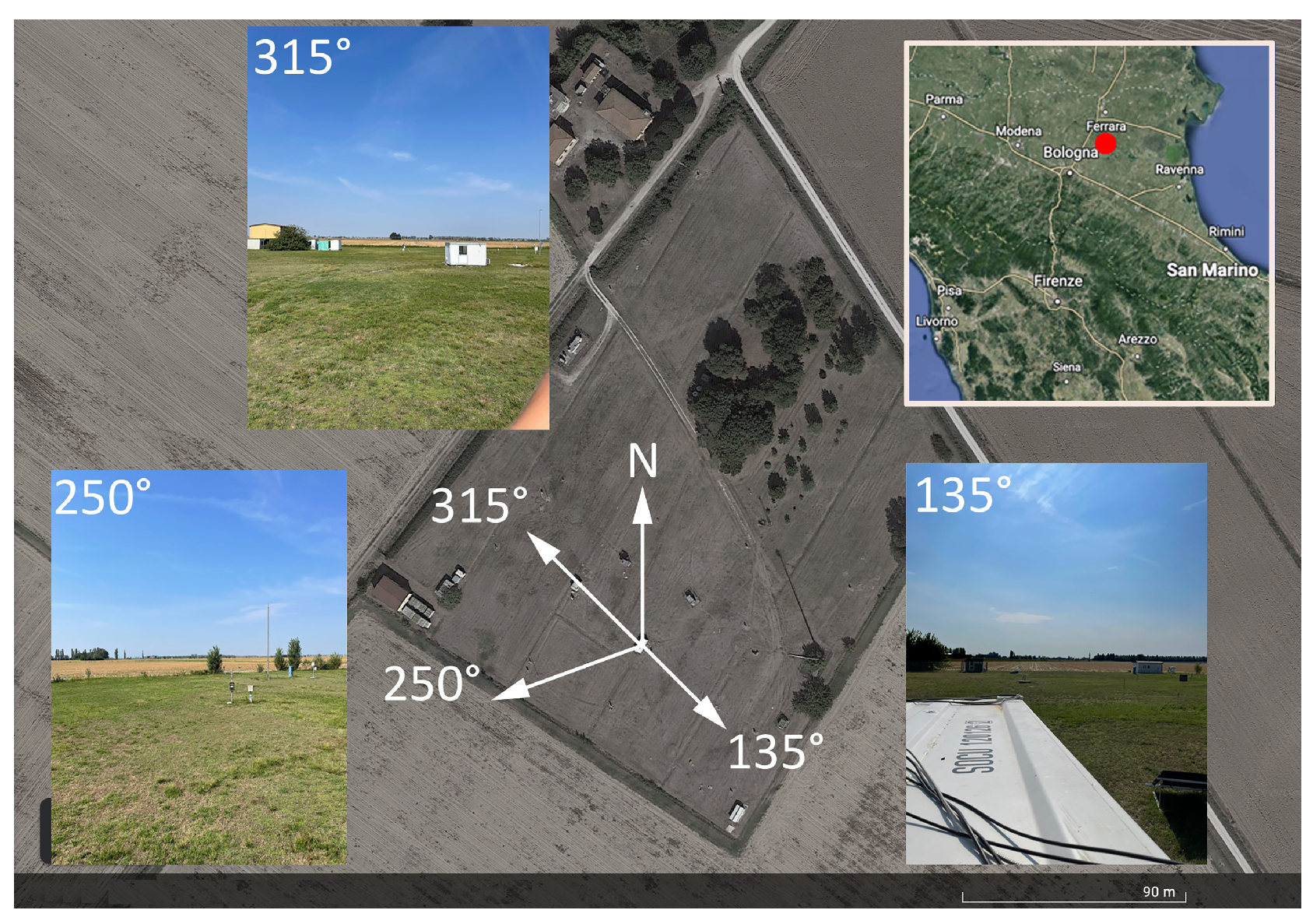



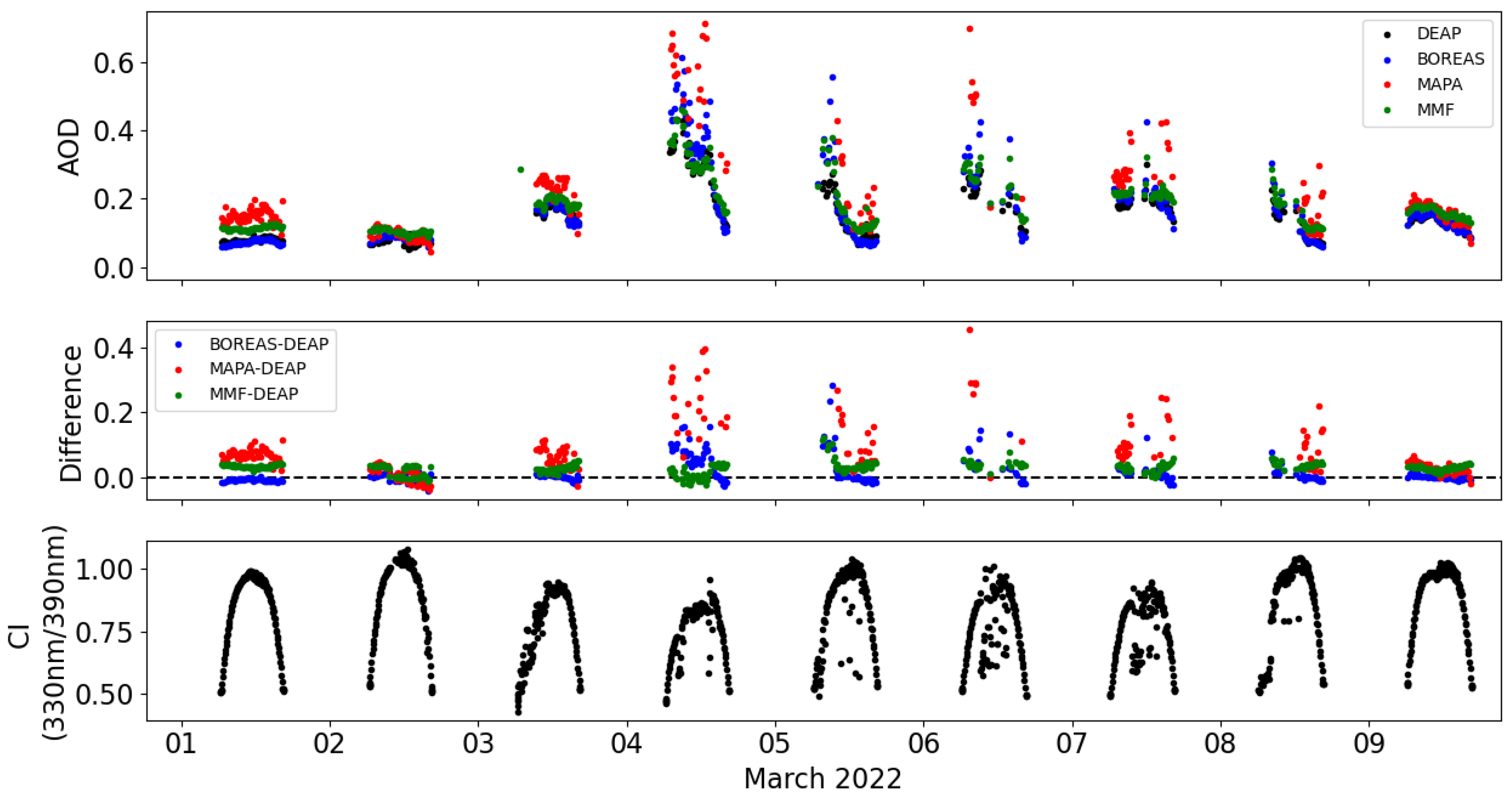
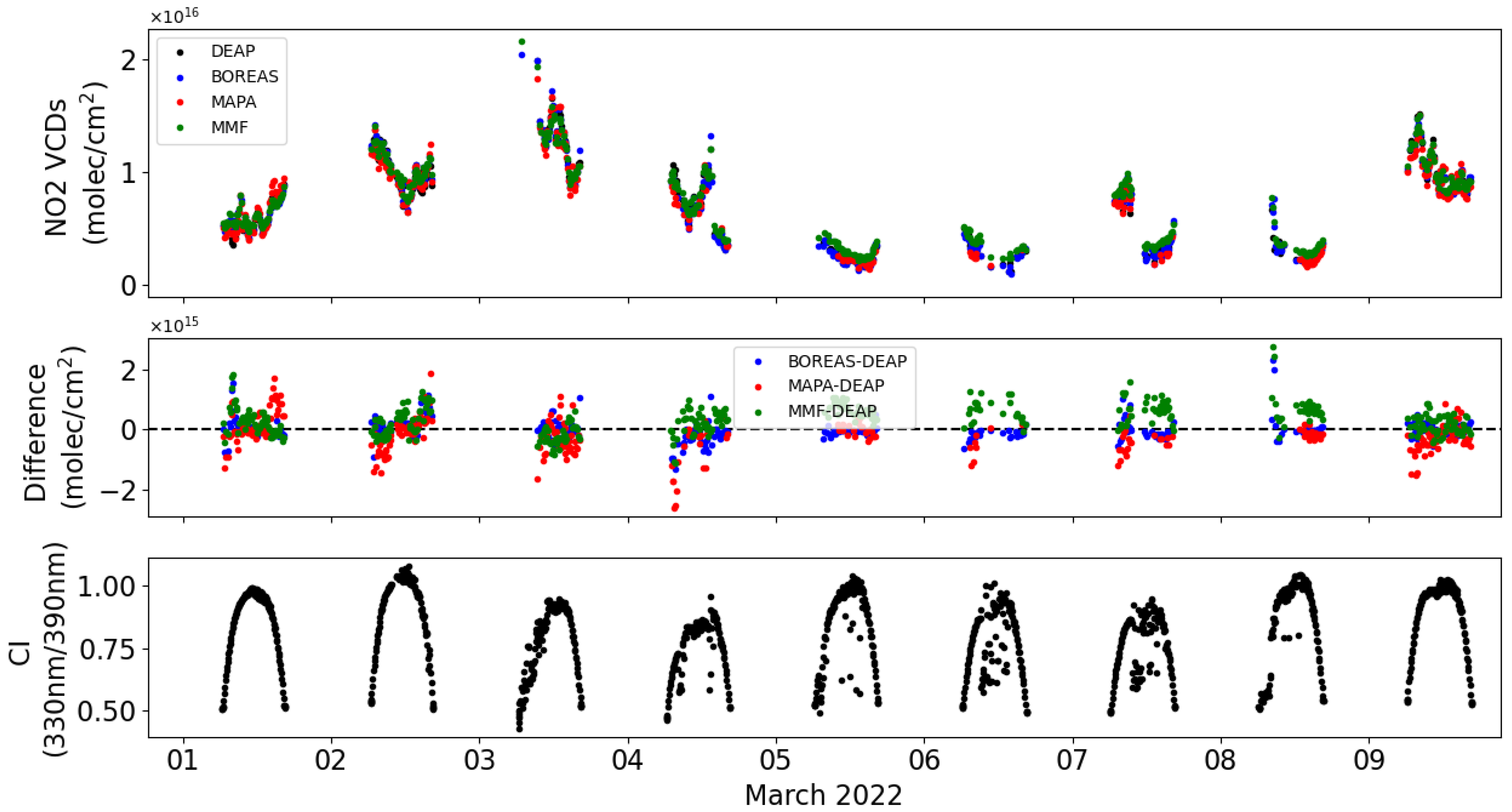


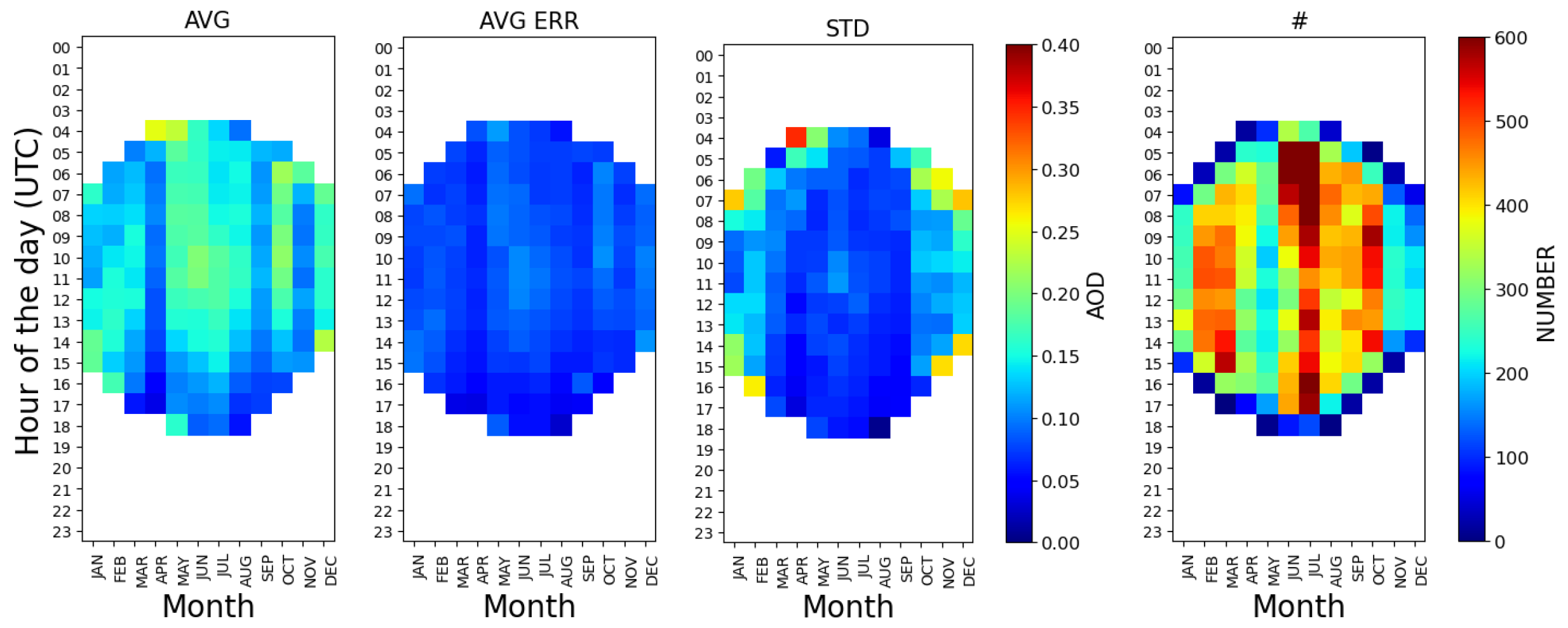
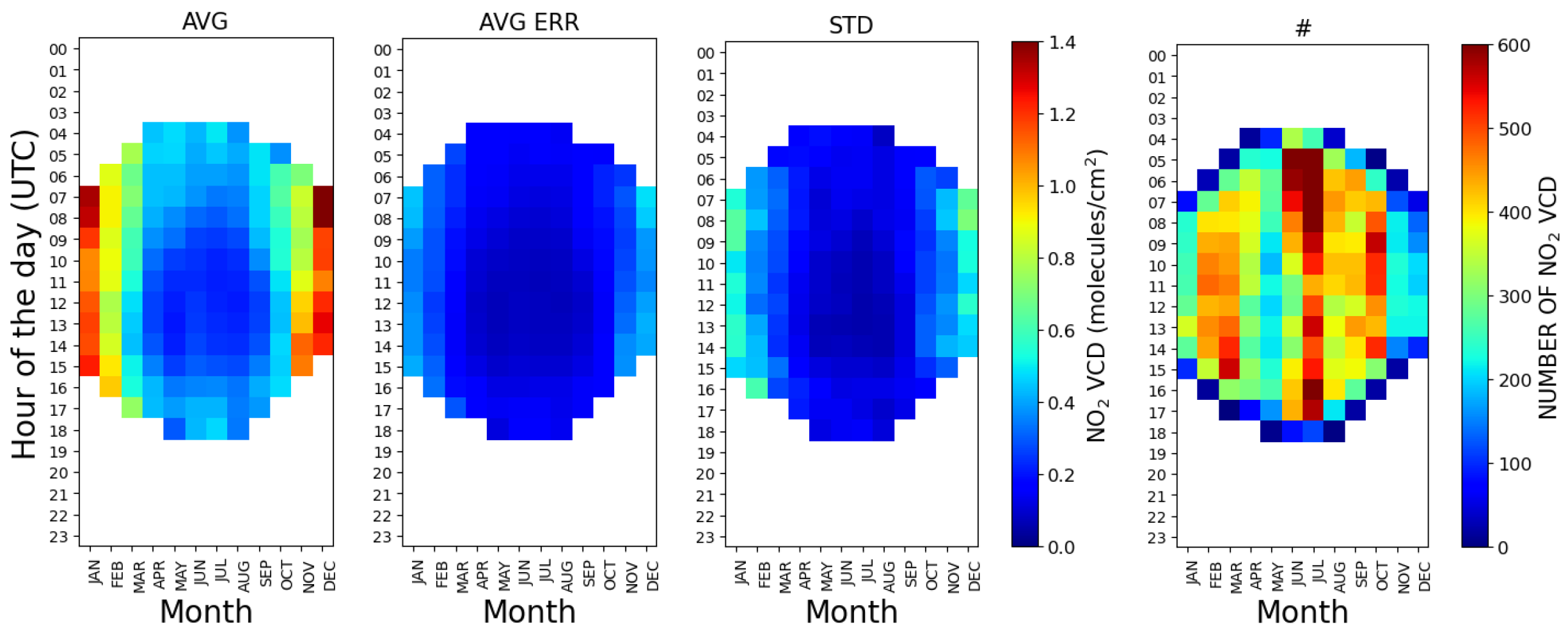
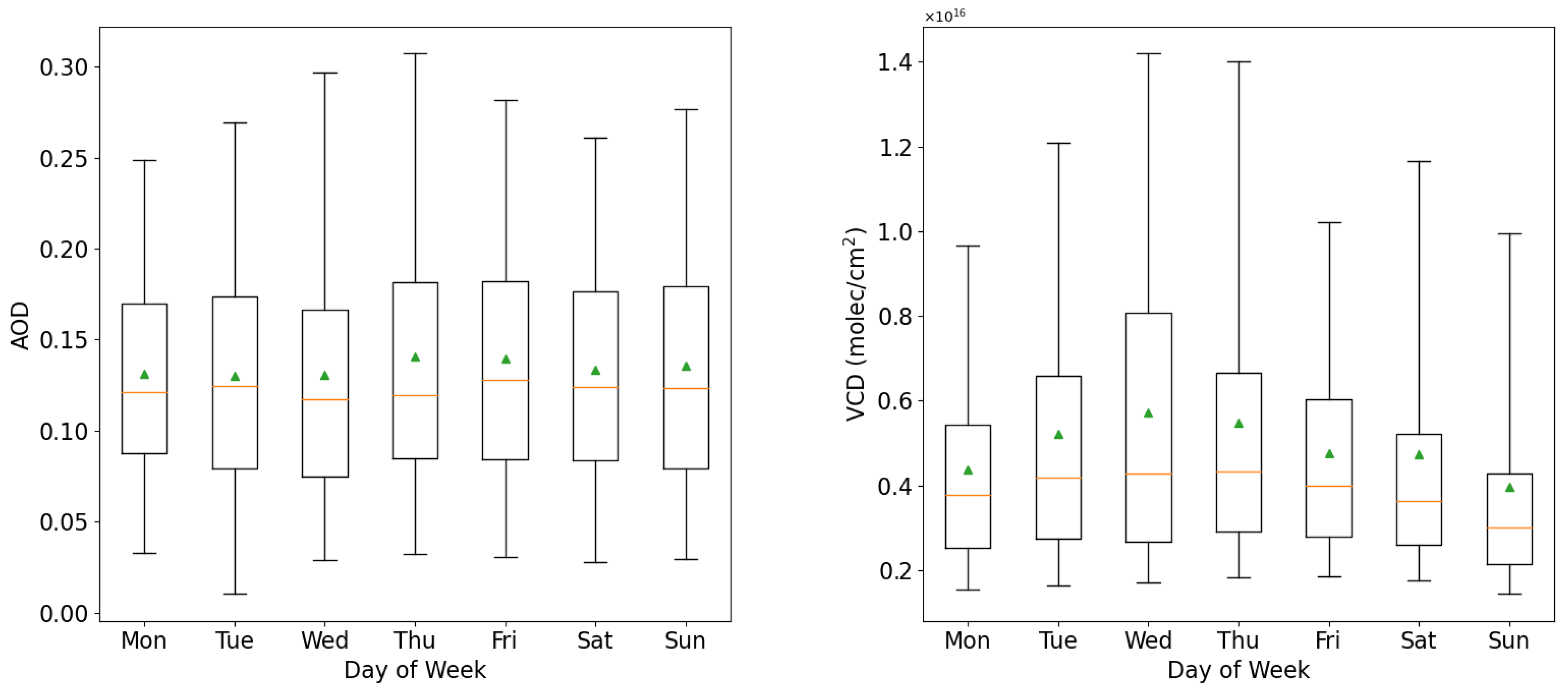



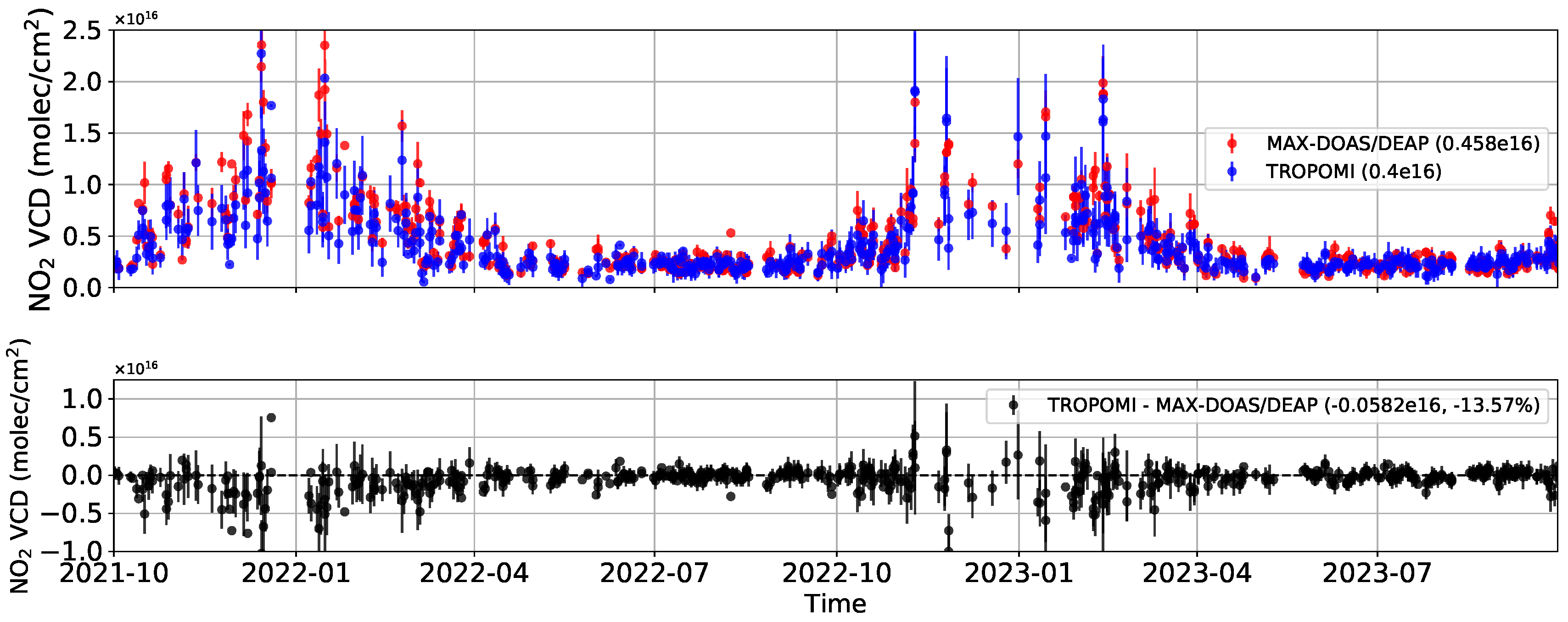
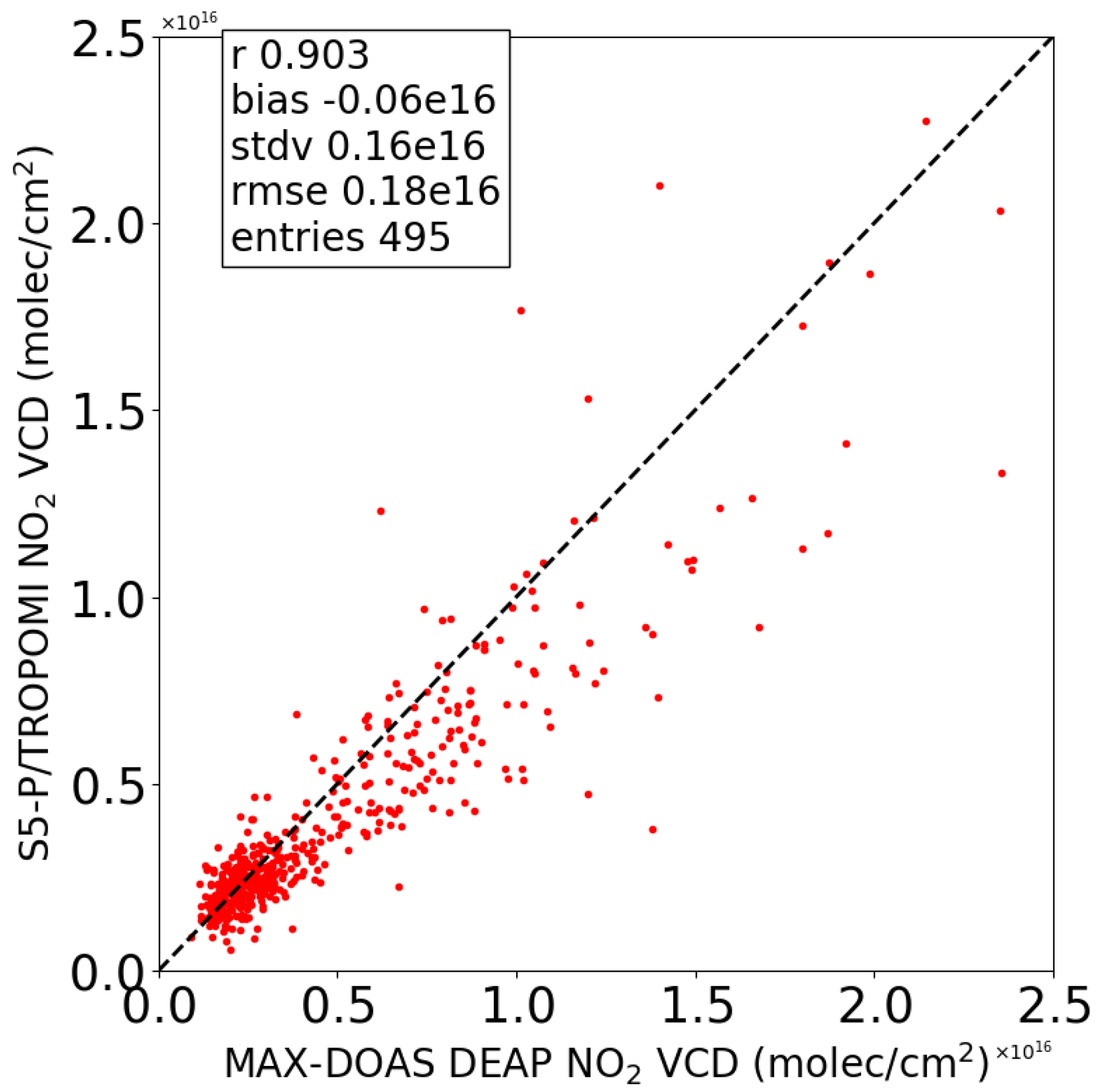
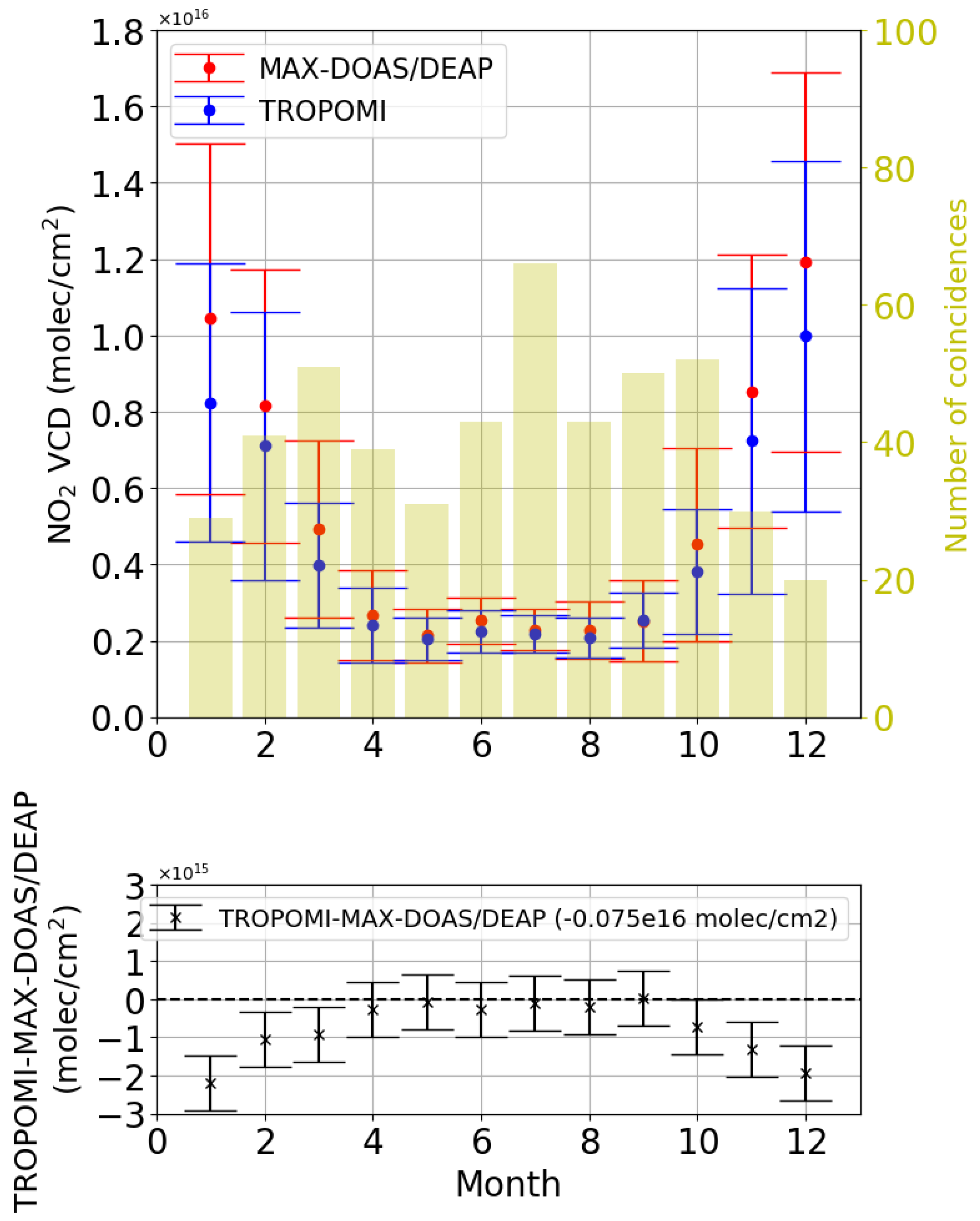

| Tropospheric | Profiles | – “v1n” | ||||||
|---|---|---|---|---|---|---|---|---|
| Aerosol 477 nm | [km−1] | NO2 [molec/cm3] | ||||||
| MAPA | MMF | BOREAS | DEAP | MAPA | MMF | BOREAS | DEAP | |
| Slope | 1.01 | 0.91 | 0.89 | 0.88 | 0.97 | 0.87 | 0.81 | 0.89 |
| Intercept | −0.00 | 0.005 | 0.008 | 0.007 | 0.015 × | 0.05 × | 0.04 × | 0.05 × |
| R | 0.89 | 0.89 | 0.91 | 0.94 | 0.85 | 0.84 | 0.66 | 0.65 |
| RMS | 0.08 | 0.07 | 0.06 | 0.05 | 0.39 × | 0.33 × | 0.62 × | 0.70 × |
| N | 10,540 | 12,260 | 12,920 | 12,700 | 10,220 | 12,440 | 11,800 | 12,320 |
| Surface | Values | – “v1n” | ||||||
|---|---|---|---|---|---|---|---|---|
| Aerosol 477 nm | [km−1] | NO2 [molec/cm3] | ||||||
| MAPA | MMF | BOREAS | DEAP | MAPA | MMF | BOREAS | DEAP | |
| Slope | 1.03 | 0.97 | 0.85 | 0.90 | 0.88 | 0.90 | 0.47 | 0.91 |
| Intercept | 0.009 | 0.01 | 0.02 | −0.009 | 0.12 × | 0.21 × | 0.14 × | −0.08 × |
| R | 0.87 | 0.91 | 0.97 | 0.95 | 0.82 | 0.90 | 0.52 | 0.83 |
| RMS | 0.17 | 0.13 | 0.09 | 0.11 | 0.9 × | 0.59 × | 1.58 × | 0.92 × |
| N | 527 | 613 | 646 | 635 | 511 | 622 | 590 | 616 |
| Tropospheric | Columns | – “v1n” | ||||||
|---|---|---|---|---|---|---|---|---|
| Aerosol 477 nm | [km−1] | NO2 [molec/cm3] | ||||||
| MAPA | MMF | BOREAS | DEAP | MAPA | MMF | BOREAS | DEAP | |
| Slope | 1.06 | 0.62 | 0.82 | 0.82 | 1.02 | 0.93 | 0.90 | 1.08 |
| Intercept | −0.024 | 0.11 | 0.05 | 0.05 | 0.03 × 1016 | 0.12 × 1016 | 0.07 × 1016 | −0.04 × 1016 |
| R | 0.90 | 0.92 | 0.88 | 0.98 | 0.96 | 0.98 | 0.97 | 0.99 |
| RMS | 0.14 | 0.13 | 0.13 | 0.07 | 0.65 × 1016 | 0.31 × 1016 | 0.18 × 1016 | 0.20 × 1016 |
| N | 527 | 613 | 646 | 635 | 511 | 622 | 590 | 616 |
| Reference Codes vs. DEAP | ||||||
|---|---|---|---|---|---|---|
| AOD | NO2 Tropospheric VCD [molec/cm2] | |||||
| MAPA | MMF | BOREAS | MAPA | MMF | BOREAS | |
| Bias | 0.02 | 0.03 | 0.01 | −0.29 × 1015 | 0.14 × 1015 | −0.008 × 1015 |
| RMS | 0.08 | 0.02 | 0.03 | 0.67 × 1015 | 0.75 × 1015 | 0.61 × 1015 |
| R | 0.70 | 0.98 | 0.97 | 0.99 | 0.99 | 0.99 |
| N | 1987 | 2796 | 2588 | 1899 | 2681 | 2500 |
Disclaimer/Publisher’s Note: The statements, opinions and data contained in all publications are solely those of the individual author(s) and contributor(s) and not of MDPI and/or the editor(s). MDPI and/or the editor(s) disclaim responsibility for any injury to people or property resulting from any ideas, methods, instructions or products referred to in the content. |
© 2025 by the authors. Licensee MDPI, Basel, Switzerland. This article is an open access article distributed under the terms and conditions of the Creative Commons Attribution (CC BY) license (https://creativecommons.org/licenses/by/4.0/).
Share and Cite
Castelli, E.; Pettinari, P.; Papandrea, E.; Premuda, M.; Achilli, A.; Richter, A.; Bösch, T.; Hendrick, F.; Fayt, C.; Beirle, S.; et al. Towards a New MAX-DOAS Measurement Site in the Po Valley: Aerosol Optical Depth and NO2 Tropospheric VCDs. Remote Sens. 2025, 17, 1035. https://doi.org/10.3390/rs17061035
Castelli E, Pettinari P, Papandrea E, Premuda M, Achilli A, Richter A, Bösch T, Hendrick F, Fayt C, Beirle S, et al. Towards a New MAX-DOAS Measurement Site in the Po Valley: Aerosol Optical Depth and NO2 Tropospheric VCDs. Remote Sensing. 2025; 17(6):1035. https://doi.org/10.3390/rs17061035
Chicago/Turabian StyleCastelli, Elisa, Paolo Pettinari, Enzo Papandrea, Margherita Premuda, Andrè Achilli, Andreas Richter, Tim Bösch, Francois Hendrick, Caroline Fayt, Steffen Beirle, and et al. 2025. "Towards a New MAX-DOAS Measurement Site in the Po Valley: Aerosol Optical Depth and NO2 Tropospheric VCDs" Remote Sensing 17, no. 6: 1035. https://doi.org/10.3390/rs17061035
APA StyleCastelli, E., Pettinari, P., Papandrea, E., Premuda, M., Achilli, A., Richter, A., Bösch, T., Hendrick, F., Fayt, C., Beirle, S., Friedrich, M. M., Van Roozendael, M., Wagner, T., & Valeri, M. (2025). Towards a New MAX-DOAS Measurement Site in the Po Valley: Aerosol Optical Depth and NO2 Tropospheric VCDs. Remote Sensing, 17(6), 1035. https://doi.org/10.3390/rs17061035







